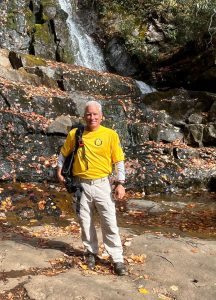
“I’m just a backwoods guy,” Bill Gober says. “I try to stay out of the limelight.”
It’s 10 a.m. on a Wednesday, the beginning of his shift volunteering with the preventative search and rescue (PSAR) team at Great Smoky Mountains National Park.
After a long career in medical equipment sales, Gober began volunteering as a rover on Laurel Falls Trail in 2012, over a decade ago. If you ask his park supervisors—PSAR Ranger Josh Albritton and Emergency Services Coordinator Liz Hall—or any of the visitors whose lives he’s helped save, they’ll tell you he’s much more than just a backwoods guy.
“Bill certainly sets the standard for our PSAR VIP [Volunteers in the Parks] cadre,” says Albritton. “He volunteers at least once per week, generally getting out on trail to educate our visitors about how to hike safely. He’s also a very active member of our SAR team, often responding from his home in Knoxville or direct from his trail post, regardless of the time of day.”
With approximately 100 carry-outs now under his belt, Gober attributes much of his enthusiasm for the park’s search and rescue efforts to his own brush with danger. In 2015, he experienced a heart attack on Laurel Falls Trail and had to call in his own rescue.
“Since I had taken the American Heart Association’s Heart Saver First Aid and CPR class as a volunteer, I recognized the heart attack signs and got out of denial early,” he says. “It’s thanks to our Great Smoky Mountains Rescue Team and their partners—Gatlinburg Fire Ambulance Team, Fort Sanders Regional Medical Center Heart Team, and Park West Cardiac Rehab—that I’m alive and well.”
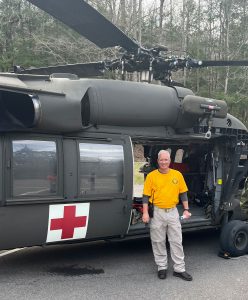
Search and rescue is personal for Gober, and he does not take his responsibility lightly. “I’ve been in the rescue basket, carried out by our rescue team,” he says. “I can identify with our injured visitors, and they bond with me quickly once they find out I’ve been in their position myself.”
Recently, Gober’s commitment to his volunteer duties has been paying off. He volunteered to take the National Registry of Emergency Medical Technicians’ Emergency Medical Responder (EMR) test, which allows him to provide direct medical care. Then, he became GSMNP’s preventative search and rescue VIP lead.
Preventative search and rescue differs from other search and rescue efforts in that it prioritizes getting people the assistance or supplies they need before a medical emergency occurs. Gober gives the example of park visitors who alert emergency services after running out of water but before they’ve become dehydrated. “That’s not a medical event yet,” he says, “but it could quickly develop into one.”
The PSAR program is relatively new to GSMNP, and it addresses a vital need. With millions of people entering the park each year, many have never experienced backcountry environments and are underprepared for situations that arise.
As journalist David Brill noted earlier this year in an article for Smokies Life, Emergency Services Coordinator Liz Hall says that instances of poor planning and insufficient preparation on behalf of visitors account for around 8 percent of all search and rescue incidents in the park. The PSAR program aims to lower that figure by helping less-experienced visitors better understand the preparation needed for a safe park outing.
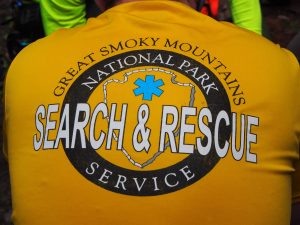
Asked if there’s anything he’d like people to keep in mind so they can enjoy the park safely, Gober says the best safety tip is also the simplest: Follow the rules. “The rules are there to keep you safe,” he says.
He’d also like people to know the park could always use more volunteers to assist with search and rescue.
“Anyone who has an interest, but particularly if they’re an EMR or EMT,” he says. “People who retire from medical careers, if they want to keep utilizing those skills, they can get on board as a volunteer and potentially participate in PSAR or search and rescue.”
Gober emphasizes that he’s grateful for the opportunity to help visitors who find themselves in emergency situations. “Growing up, I wanted to be a park wildlife ranger,” he says. “My hero was Smokey Bear, and I wanted to help Smokey save the world from forest fires. So, it’s an honor for me to support our professional Great Smoky Mountains team. Hopefully, I have many more years to volunteer and help our visitors enjoy the park in a safe, responsible manner.”
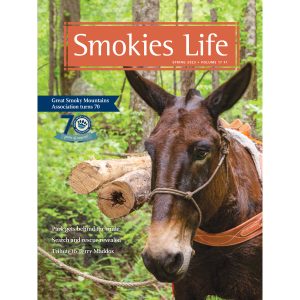
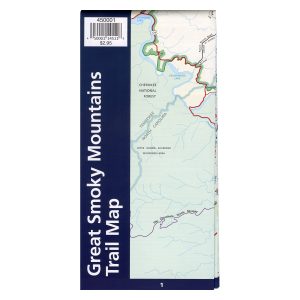

Subscribe to get the latest posts sent to your email.
The Great Smokies Welcome Center is located on U.S. 321 in Townsend, TN, 2 miles from the west entrance to Great Smoky Mountains National Park. Visitors can get information about things to see and do in and around the national park and shop from a wide selection of books, gifts, and other Smokies merchandise. Daily, weekly, and annual parking tags for the national park are also available.